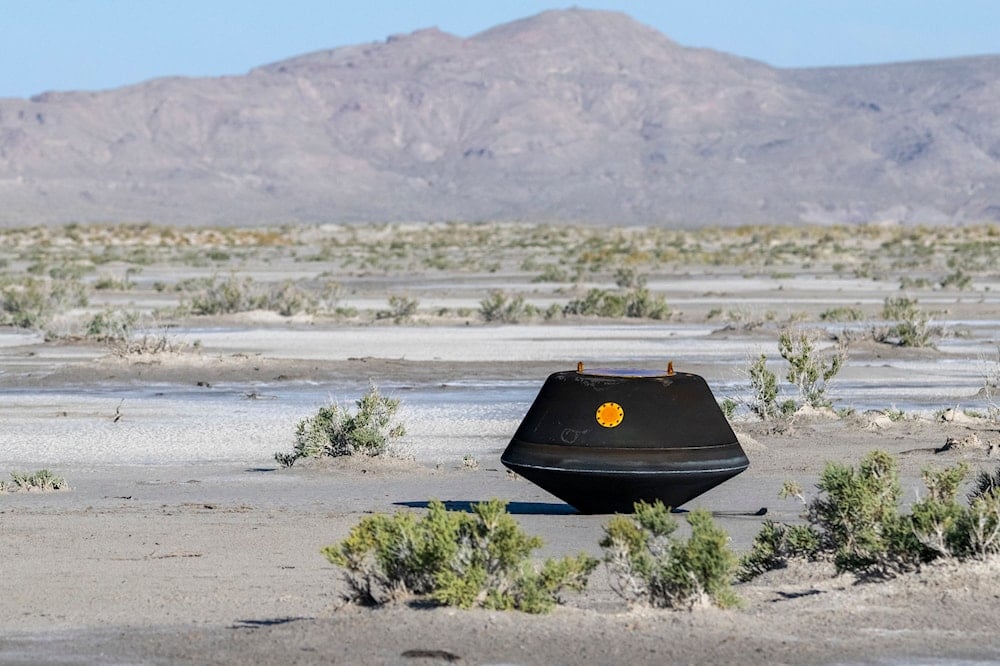Key life elements found in Bennu asteroid dust, rock samples
The finding bolsters the theory that asteroids delivered the ingredients for life to Earth.
-

Researchers identified salt minerals in the Bennu samples that were deposited as a result of brine evaporation from the asteroid’s parent body. (@NASA/X)
Planetary scientists have identified organic matter crucial for life within dust and rock collected from the asteroid Bennu. This discovery reinforces the theory that near-Earth asteroids, such as Bennu, may have contributed to life’s origins on Earth.
According to two papers published Wednesday, researchers detected 14 of the 20 amino acids essential for protein formation, along with all five molecular components of DNA and RNA, in mineral-rich brine deposits on Bennu’s surface.
The findings suggest that the chemical precursors of life might have traveled from distant regions of the solar system before landing on a suitable planet or moon, explained Tim McCoy, curator of meteorites at the Smithsonian Institution’s Museum of Natural History and lead author of a study published in Nature.
"We’re talking about the earliest steps that lead towards life," McCoy said.
LIVE: Experts provide an update on science results from the OSIRIS-REx mission, which brought samples from asteroid Bennu back to Earth in September 2023. https://t.co/zPNpf3DHye pic.twitter.com/g34XEyzZNo
— NASA (@NASA) January 29, 2025
However, life itself never emerged on Bennu, as the necessary chemical conditions were not sustained long enough. "In addition to having the environment and the ingredients, you also need time and probably temperature, and we probably didn’t have those for long enough or hot enough for this to happen on an asteroid," McCoy noted.
Dive deeper
The sample was retrieved by NASA’s OSIRIS-REx spacecraft, which launched in 2016 on a mission to analyze Bennu. In 2020, the spacecraft collected a soap bar-sized sample of rock and dust before returning to Earth three years later, releasing a sealed capsule in the Utah desert.
Bennu, a 1,600-foot-wide rubble pile that formed 4.5 billion years ago, originally fragmented from a larger asteroid before reassembling. It orbits close to Earth every six years, coming within 186,000 miles—closer than the Moon.
Its parent asteroid once contained liquid water, which evaporated over time, leaving mineral-rich brines similar to the dried salt crusts found in Earth’s lakebeds. These minerals provided the foundation for amino acids and other organic molecules.
At NASA’s Goddard Space Flight Center in Maryland, scientists ground tiny fragments of Bennu into powder and created a "Bennu tea" by boiling them in water. This process allowed them to extract and analyze organic compounds, explained Jason Dworkin, an astrobiologist at NASA Goddard and co-author of a study published in Nature Astronomy.
Many questions remain unanswered, including why life never developed on Bennu’s parent asteroid and whether similar conditions exist elsewhere in the solar system—such as on Saturn’s moon Enceladus, Jupiter’s moon Europa, or Ceres, a dwarf planet in the asteroid belt between Mars and Jupiter. Further studies on the Bennu sample are underway.
"This gives us a firsthand report of a negative control for life," Dworkin said. "A place that had all the stuff, but life didn’t get going."

 3 Min Read
3 Min Read








